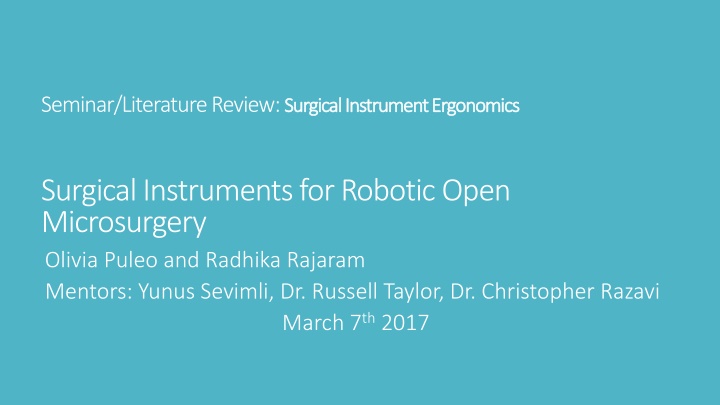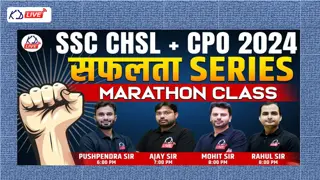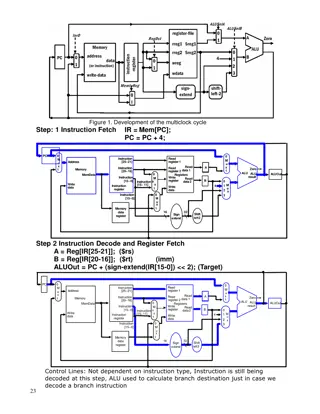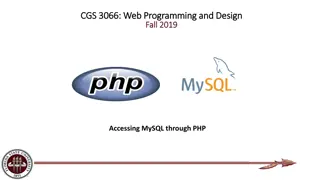
Ergonomics in Surgical Instrument Design for Microsurgery
Explore the importance of ergonomics in designing surgical instruments for microsurgery, focusing on factors like handle design, tool placement, and environmental considerations. Discover insights from literature reviews and studies, including areas for improvement and key ergonomic principles.
Download Presentation

Please find below an Image/Link to download the presentation.
The content on the website is provided AS IS for your information and personal use only. It may not be sold, licensed, or shared on other websites without obtaining consent from the author. If you encounter any issues during the download, it is possible that the publisher has removed the file from their server.
You are allowed to download the files provided on this website for personal or commercial use, subject to the condition that they are used lawfully. All files are the property of their respective owners.
The content on the website is provided AS IS for your information and personal use only. It may not be sold, licensed, or shared on other websites without obtaining consent from the author.
E N D
Presentation Transcript
Seminar/Literature Review: Surgical Instrument Ergonomics Surgical Instrument Ergonomics Surgical Instruments for Robotic Open Microsurgery Olivia Puleo and Radhika Rajaram Mentors: Yunus Sevimli, Dr. Russell Taylor, Dr. Christopher Razavi March 7th2017
Aim Develop normally-open microvascular needle driver and/or forceps that can be integrated with Galen robot 1) Held at the top by the surgeon 2) Held at the middle by the robot 3) Allows for rotation about own axis 4) Ergonomic and dexterous 5) Design for manufacturability & sterilizability Surgical Instrument Ergonomics Surgical Instrument Ergonomics 1) Design considerations for microsurgery 2) Tasks, models, evaluation methods (in laparoscopy) 3) Postural analysis tool Kumar et al.,MICCAI 99
Areas for improving ergonomics 1) Tool itself - affects fingers, wrist, shoulders etc. 2) Location of tool in workspace affects neck, eyes, overall posture 3) Environment (lighting, noise, temperature) 4) Participant numbers (nurse, endoscope holder) 5) Variety, order, frequency and duration of tasks
Paper 1: ERGONOMICS APPLIED TO THE PRACTICE OF MICROSURGERY Patkin, M. (1977), ERGONOMICS APPLIED TO THE PRACTICE OF MICROSURGERY. Australian and New Zealand Journal of Surgery, 47: 320 329. This paper examines five aspects of microsurgery where ergonomics is important (i) visual feedback (ii) accuracy of hand movement and control of tremor (iii) the acquisition of skill (iv) hand grip used for precise work (iv) hand grip used for precise work (v) design and care of microsurgical instruments
Handle design Microsurgical grip different from pen grip Three main movements: A) Protraction, retraction B) rotation C) pinch/trigger A) Length of handle about 10 cm; the distance from fingertips to instrument tip will depend on access to the tissues at operation B) Handle cross-section circular, milled for friction C) Diameter of handle 5-10 mm D) Force required for closing is 40 100 gm E) Mechanical advantage : 6:1 Microsurgical vs Pen grip Patkin et al., . ANZ 1977
Assessment Positives: Mentions dimensions required exactly, along with biomechanical reasons behind them Actionable suggestions for tool and workplace design Negatives: Outdated paper- manufacturing has improved greatly over 3 decades Based on conventional surgery and not robotic assisted surgery
Paper 2: Tasks ,Models and Measurement Systems (Laparoscopy) Lee, G., Lee, T., Dexter, D., Klein, R., & Park, A. (2007). Methodological Infrastructure in Surgical Ergonomics: A Review of Tasks, Models, and Measurement Systems. Surgical Innovation, 14(3), 153-167. Types of tasks: 1) Static Static opening and closing of instruments, no motion of tool tip 2) Simple navigation Simple navigation Operation game 3) Manipulation Manipulation - pushing small object into small aperture, instrument-instrument rope passing, Cable passing, shape cutting, suturing, tying Fundamentals of Laparoscopic skills (FLS)
Environments for testing 1) Operating Room Operating Room- - on cadavers, phantoms 2) Training box Training box- - confined space roughly approximating the abdominal cavity into which ports may be placed to allow instrument access, camera within for recording 3) Virtual Reality simulators Virtual Reality simulators visual, audio and haptic feedback By measuring the success rate and speed of completion, we can compare the ergonomics of different instrument designs
Measurement methods 1) Self-reported (subjective). Study participants fill out questionnaires, surveys Eg: Subjective Mental Effort Questionnaire (SMEQ) and the Local Experienced Discomfort (LED) scale SMEQ Subjective Mental Effort Questionnaire Olivier et al., Surgical Endoscopy 2009
LED Local Experienced Discomfort Olivier et al, Surgical endoscopy 2009
Measurement methods 2) Measured with sensors (objective): a) Motion analysis: video- manual analysis, optical tracking , EM tracking, Orientation sensor Optical motion systems capable of handling hundreds of markers- Measure flexion/extension, abduction/adduction, internal/external rotation , CoM Factors to consider: occlusion, interference, space requirements Ultrasound tracking Zebris, Isny, Germany
b) EMG- Electro-myography Muscle exertion causes change of the action potentials which can be measured just above the skin using electrodes EMG data analysis relates muscle activation to outcome (force, torque, movement, fatigue level) Three types of analysis: 1) Amplitude of EMG signal averaged over time 2) Percentage of Maximum Voluntary Contraction (% MVC) 3) Frequency analysis task induced fatigue
c) Force plate Systems Plates that measure Ground Reaction Force (GRF) through piezoelectric transducers or strain gauges Can provide: 1) 3D resolution of force 2) 2D coordinates of Centre of Pressure 3) rotational moments about x, y and z axes This system is good only for overall posture measurement
Assessment Positives: A thorough classification and description of tasks and measurement methods Applicable to both tool and workspace integration ergonomics Discusses advantages and limitations of the various methods Has been used to evaluate robot assisted surgeries Negatives: Does not provide a scoring system that can give actionable advice
Paper 3: Rapid Entire Body Assessment (REBA) Hignett, S., & Mcatamney, L. (2000). Rapid Entire Body Assessment (REBA). Applied Ergonomics, 31(2), 201 -205. Postural analysis tool specifically developed for healthcare practitioners Features of REBA: 1) Sensitivity to musculoskeletal risks in a variety of tasks 2) Segmentation of body and coding of segments 3) Scoring system for muscle activity caused by static, dynamic, rapid changing or unstable postures 4) Hand hold is given importance 5) Action level with indication of urgency 6) Only pen and paper required
REBA scores Group A parts: Leg Neck Trunk - 60 posture combinations Group B parts: Upper arms Lower arms Wrists -36 posture combinations Group A+ B: 144 combinations
REBA scores
Example- physiotherapist with patient Group A: Trunk is flexed more than 60 degrees, side flex (4 +1) Neck is extended (2) Legs are both weight bearing and flexed more than 60 degrees (1 +2) Load force < 5 kg (0) Group B: Upper arms flexed between 45 to 90 degrees, abducted, gravity assisted (3 + 1 -1) Lower arm flexed less than 60 degrees (2) Wrist 0 to 15 degrees (1) Coupling: (1) not ideal hand-hold
REBA action level 10 + 1 = 11 (A-B table+ action) High risk task!
Assessment Positives: REBA tool has been evaluated for over a decade and found to be quite accurate and popular Easy to understand and use Has been used to evaluate robotic assisted surgeries Negatives: Does not deal with fingertip forces
Conclusion 1) Papers together make comprehensive resource for ergonomic design and evaluation 2) Our surgical instrument is integrated with a robot, we may face unique challenges while trying to implement safe and effective instrument design 3) We do not aim to test the instruments with experienced surgeons, the knowledge of correct working posture can help in our self-evaluation. Questions?






















